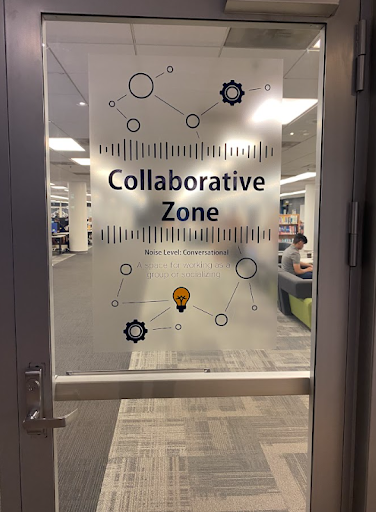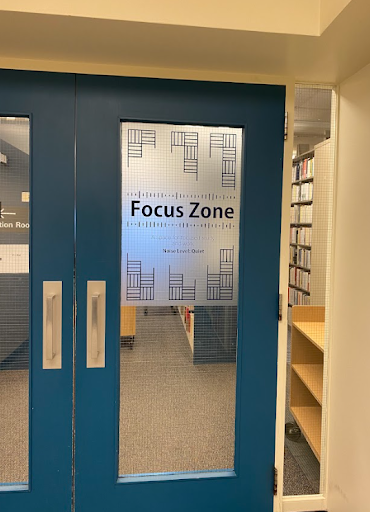Introduction
The Library Environments Department works to improve the in-person library experience by making our buildings more functional, welcoming, and accessible. With this mission in mind, the team has conducted various research projects related to study spaces on campus to explore the needs and pain points of users with diverse backgrounds. Based on prior research, Library Environments heard that users would like more information about what to expect from a study space so they can match the work they’re doing to the study environment. As a result, we labeled the 4th floor in Hatcher Library as an official “Focus Zone” and the zoned space on the 1st floor in Shapiro Library a “Collaborative Zone.” With signage and website changes in place the zoned spaces officially took effect on the first day of class of the Fall 2022 semester.
After implementation, we received some complaints from students about people using areas in the Focus Zone to speak loudly or do Zoom calls. We also heard feedback that some students perceived the Collaborative Zone as a place for quiet study since at certain times of the day there is not a lot of noise on the floor. Students who saw the space this way expressed at times feeling uncomfortable speaking freely in the space.
Based on this information, it seemed like signs were not effective in these two buildings, and not consistent with the expectations among users. Our hypothesis was that the signs might be misleading or not obvious to students when entering a “Collaborative” or “Focus” zone.
We wanted to investigate the reasons that led to such inconsistent expectations in these zones and learn more about why some students were not following our listed expectations. We decided to ask about students’ experiences using the zoned spaces as well as for their suggestions to improve the signs and the spaces.

[The sign on the front door of the Collaborative Zone]

[The sign on the front door of the Focus Zone]
What We Did
To get started I created a research plan along with study protocols for the two spaces respectively. Since the goals were to get students' feedback about the sign design, and solutions to keep the noise level consistent in the zoned spaces, I chose focus groups as the main methodology and incorporated participatory design into the focus group sessions. Focus groups allowed us to collect information about students’ perceptions and opinions of the zoned spaces and the signs. This method also encouraged open and free discussions and brainstorming of ideas for solutions to the problems that participants identified. Participatory design, which I integrated into the Collaborative Zone focus group through a design activity where participants were asked to redesign the door sign on paper with pencils, pens, and colorful markers, allowed us to better understand how students would design the sign that makes the most sense to them if they were the designer.
Volunteers were recruited through fliers placed in the spaces to ensure that people signing up already had experience using the spaces. To ensure a heterogeneous group, students with diverse backgrounds in ethnicity/race, major, and year in school were selected from a list of volunteers who filled out a survey screener. We conducted two in-person focus group sessions for each of the zoned spaces. For the Collaborative Zone, 5 out of 12 students we recruited participated in the research. Each session lasted for one and a half hours. Participants were compensated with a $20 gift card. For the Focus Zone, 10 out of 13 students we recruited participated in the sessions. Each session lasted for an hour. Participants were compensated with a $15 gift card.
What We Found
Key findings of the Collaborative Zone:
-
The description on the sign is hard to see and evokes confusion with abstract graphics that do not help increase the understanding of the space
-
Not many people noticed the sign at first, but they learned about the expectations from other resources and environmental cues
-
Students love the capsule seating (a particular piece of furniture that gives students some privacy, their own reading lamp and a footrest) and the study vibe in the space
-
Many come alone to do individual work and appreciate more single tables and capsules
-
Everyone wants to have more charging stations
Key findings of the Focus Zone:
-
People being loud in the space is the main challenge
-
The sign on the front door is helpful, some people even felt that the noise level had gone down in the space since the sign was put up, but more reminders inside the space are needed
-
The language used in the sign is not clear and specific enough
-
Students love the uniqueness of carrels and the variability of views
-
Replacing broken window blinds and uncomfortable chairs and extending the hours would improve the experience
Recommendations
Collaborative Zone:
- The sign needs to be redesigned to convey a clear message (i.e. more colors, use relevant images, remove the description that does not reflect the real usage of the space)
- Add more cues in the environment to cultivate a sense of a conversation-friendly space (i.e. paint the pillars with images of people speaking or signs)
- Purchase more single tables and capsule seating
- Add more power outlets with longer cords
- Improve the capsule seating and the couch space to make it more comfortable for people to use for work and study
Focus Zone:
- Use more concrete language and meaningful graphics to reduce misunderstanding of the sign
- Put more reminders of the quiet policy with alternative options for conducting zoom calls or working collaboratively in each carrel where everyone can easily see
- Purchase new chairs that are more comfortable and can adjust the height
- Replace the old and broken blinds and add blinds to those that do not have them
- Extend the library operations if possible
What I Learned
Through this project, I learned to be creative with research methods to approach a problem. For example, including participatory design seemed to be a perfect approach to capture what graphics and language that students think would best communicate the goals of the space. In short, it allowed us to be in the shoes of students. This also added an element of fun compared to a focus group session with pure discussions.
This was my first time conducting research in the library space. One thing that I found different from the research in the tech industry was that no-shows were quite common. While we recruited 12 students for the collaborative zone, only 5 people showed up. The compensation was good for students, so I didn’t anticipate such a low participation rate. But I guessed it might be due to the busy schedule of students and their commitment cannot compare with the commitment of those who received more than $100 for research participation in the industry. So, I learned to be prepared for no-shows.
I gained valuable experiences of planning and executing focus groups through this project, because I became much more confident and comfortable leading a focus group after facilitating four sessions. Focus groups are different from other UX research methods that are typically just the researcher and the participant. To make sure everyone is comfortable sharing their experiences and opinions, I learned to be fully attentive to the group discussion and dynamics by using a physical copy of the protocol to reduce distractions.
Prior to this project I hadn’t participated in any formal in-person user research. In-person research has more interactions with the participants than research conducted remotely since the researcher may need to lead the way for the participant so there will be more time for conversations before the session starts. Because I wanted to build rapport with the participants, I found it very helpful to have some small talk topics ready to make participants feel comfortable speaking and being in the room. The flexibility to move around the space and see the body language of the participants helped me be more comfortable and gave me more cues to understand the participants. Overall, I found it was fun to conduct in-person user research.
What's Next
Findings and recommendations from these sessions will be combined with feedback given by library staff about this trial set up of zoned spaces. We look forward to making improvements to our setups and continuing to respond to users’ study space needs in the library. For more information about this work, feel free to email libraryenvironments@umich.edu.